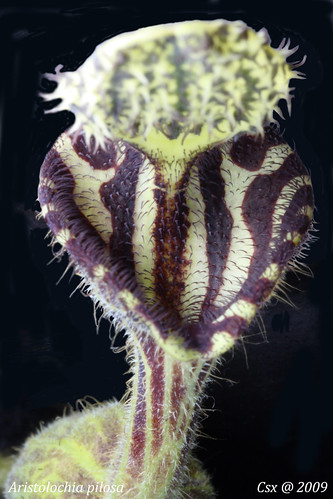
With reference to the above photos, it is no wonder that this species is called Aristolochia pilosa, where ‘pilosa’ is derived from the word ‘pilose’, which means to be covered with hair. Not only is the inner lining of the flower covered with trichomes, the outer part of the flower, as well as the leaves and stems of the plant are also covered with a layer of hair. A purpose for the hair has yet to be discovered, though on another Aristolochia species, the short hairs covering the surface of the leaves trap insects like fly-paper.
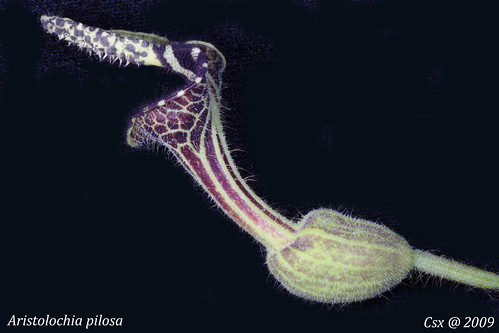
The flower is primarily a light-green, with purple-brown stripes along the outer part of the tube as well as the on the inner surface of the limb. The purple-brown markings may serve as a short range attractant for pollinators. A faint scent of over-ripened fruit can also be detected from the over-hanging fimbriae of the flag of the flower, where the osmorphores are located, on Day 1 of the flower’s opening, which serves as a long range attractant. No scent was detected in Day 2 or 3 flowers.
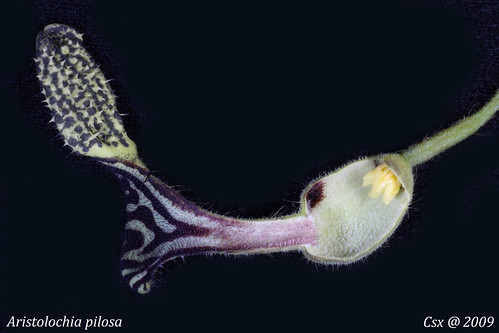
This is a cross section of a Day 1 flower. As can be seen, the trichomes lining the inside of the limb and tube are all erect, as are the fimbriae on the flag of the flower. Osmophores located on the flag produce a scent which attracts flies from a long distance away. These flies alight on the flag or limb of the flower, and then proceed to crawl further down the limb, past the annulus, into the tube of the flower.
The inner part of the tube is densely lined with trichomes which are mono-oriented, which serves 2 practical purposes. Firstly, the trichomes, as well as the tube, restrict the size of insect able to enter the flower and interact with the gynostemium. Too big an insect, and it may/will damage the gynostemium as it moves around the utricle, too small an insect and it will not be effective as a vector to transfer pollen from one flower to another. Bigger insects are kept out via the smaller effective diameter of the inner tube + trichomes, while smaller insects are kept out because they are not strong enough to force their way past the trichomes. Secondly, the trichomes, because of their inward mono-orientation, serve to prevent insects that have already started crawling in the tube from backtracking. Much lesser energy is required to push past the trichomes inwardly than to push them the opposite direction.
The syrinx is the portion of the tube just before the utricle, consisting of an even denser layer of trichomes than the rest of the tube. It serves as a final barrier that the insects have to crawl through before entering the utricle. The syrinx also serves to prevent insects from exiting the utricle on Day 1. Upon crawling into the dark utricle insects encounter a halo of light around the gynostemium, which is done through the ring of ‘window pane’ cells around the gynostemium which permit light to pass through. The insects display positive phototaxis, and are attracted to the light, moving to the gynostemium, where receptive stigmatic lobes await any pollen that may be attached to the insect from a previous visit to another flower of the same species.
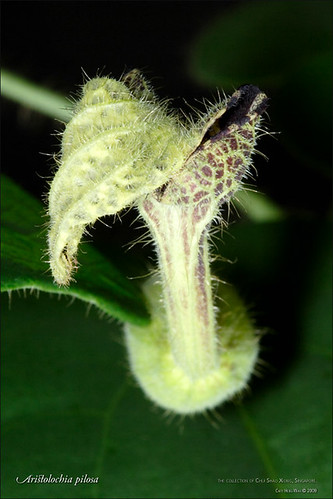
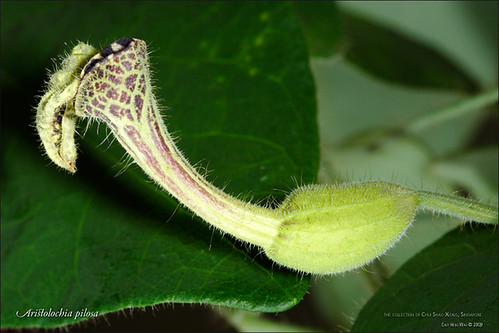

No comments:
Post a Comment